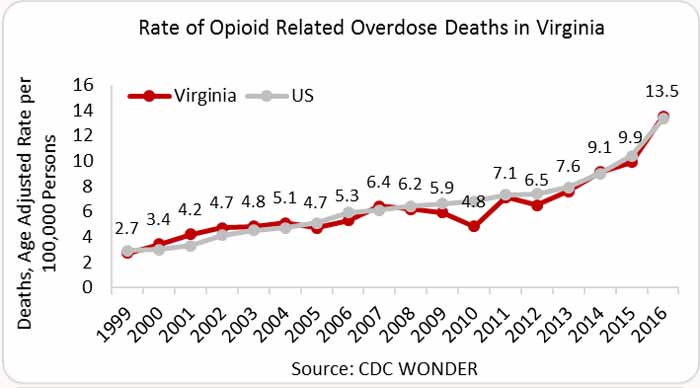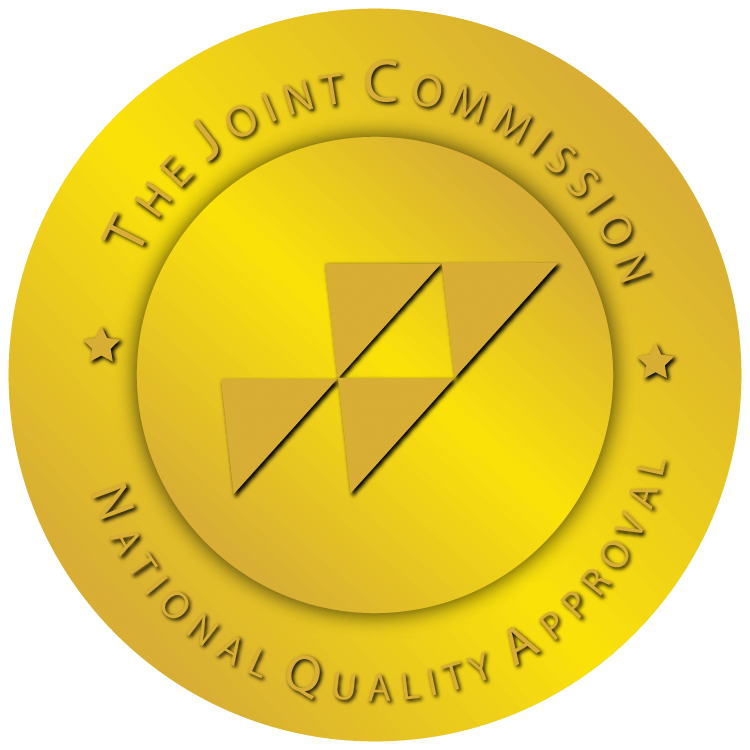The area of Maryland, Pennsylvania, West Virginia, and Virginia have been hit especially hard by the opioid crisis in America. While Virginia isn’t the worst state in the U.S. when it comes to opioid overdoses and deaths – West Virginia was the hardest hit – Virginia has seen record increases in the amount of people addicted to and seeking addiction treatment for opioid addiction in Virginia.
How the Opioid Epidemic is affecting the State of Virginia
2016 was the worst year on record for accidental drug deaths and overdoses from heroin and opioids. More than 63,600 people died from overdoses in 2016 in the United States, increasing from 52,400 in the previous year (2015).
In Virginia, overdose deaths numbered 16.7 per 100,000 residents; or 13.7 per 100,000 – when adjusted for age. That is a 149% increase in drug-related overdose deaths in Virginia since 2006. The age group hit hardest by overdoses is the 35-44 year age groups, and Tazewell County was the hardest hit area.
Drug Overdose Rates in Virginia versus West Virginia
When compared to West Virginia – the hardest hit state – the numbers show that the Virginias together are really struggling with slowing down or decreasing the number of deaths from prescription opioids and heroin.
- The age-adjusted rate of opioid overdose deaths in West Virginia is 45.2 per 100,000; Compared to 13.7 per 100,000 in Virginia.
- The 10 year increase in overdose deaths in West Virginia is 167%; compared to 149% in Virginia.
- The most impacted age group for opioid-related overdose deaths is the 25-34 year age group for West Virginia – much younger than the 35-44 year age group in Virginia.
The highest rate of drug overdose deaths in West Virginia was seen in Logan County, and Logan County is ranked 20th in the Nation for highest risk of HIV and hepatitis C due to intravenous drug use.

Mental Health Issues Worsening the Opioid and Addiction Problem in Virginia
While the opioid crisis in America was worsened by over-prescribing, and what has been called a systematic failure of our health system to look out for the best interest of patients, researchers are now pointing their fingers toward a rampant mental health crisis as a secondary cause to the increase in addiction and deaths.
Addiction Treatment Specialists have long-known the connection between poor mental health, substance abuse, and addiction. While many addiction treatment facilities now offer mental health treatment as a part of addiction treatment – also called dual diagnosis treatment or substance abuse treatment for co-occurring disorders – a general lack of mental health treatment and lack of affordable dual diagnosis programs has worsened the epidemic.
“Dual diagnosis treatment programs have been shown to be more effective at treating both addiction and the underlying mental health disorders that worsen substance abuse, and offer better relapse prevention than traditional treatment clinics without mental health counseling.”
Virginia State Opioid Policies
- As of 2018, all Virginia counties have completed a CDC consultation on risk factors for opioid addiction and HIV/Hepatitis risk.
- Syringe Exchange Programs are currently legal in the State of Virginia.
- In the State of Virginia, prescribers are currently required to check Virginia PDMP prescription drug monitoring databases before prescribing any type of opioid medication.
- The Virginia Board of Medicine adopted emergency regulations 18 VAC 85-21-10 on Mandatory Prescribing Regulations for Treating Pain and Addiction. These emergency regulations set new guidelines for opioid and buprenorphine prescriptions.

Source: National Institute on Drug Abuse
Virginia Opioid Statistics
Heroin and other opioids have caused catastrophic increases in early deaths in the state of Virginia. In addition to heroin deaths increasing tenfold from 2010 to 2016 (from 45 deaths to 450 deaths), deaths related to synthetic opioids like fentanyl and the extremely deadly elephant tranquilizer Carfentanil rose from 87 deaths to 648 in 2016.
Opioid-Related Neonatal Abstinence Syndrome (NAS) in Newborns in Virginia
The rate of drug addicted babies born to mothers addicted to opioids has been increasing rapidly alongside the increases in opioid use attributed to the opioid epidemic. Cases of NAS have been especially high on the East Coast in States like Maryland, Massachusetts, Virginia, and Pennsylvania.
773 babies were born addicted to opioids in Virginia in 2016. That is a rate of 8 cases per 1000 births – well above the National average of 6.0 cases per 1000 births.
Opioid Overdose Statistics in Virginia
2016
- Drug overdose deaths in Virginia increase from 1,005 deaths in 2015 to 1,387 in 2016 – a 38% increase. ***
- Heroin overdose deaths in Virginia increased from 339 in 2015 to 451 in 2016. ***
- Overdose deaths in Virginia due to natural and semi-synthetic opioids increased from 270 deaths in 2015 to 346 deaths in 2016. ***
- Methadone-related overdose deaths in Virginia actually decrease from 2015 to 2016, with 73 deaths attributed to methadone in 2015 and 70 deaths in 2016. ***
- Synthetic opioid overdose deaths increased the most from 2015 to 2016, with 263 deaths attributed to synthetic opioids in 2015 and 692 deaths in 2016 (Methadone not considered in these figures). ***
- Fairfax County, VA reported 108 drug related overdose deaths, the most deaths in a single county in Virginia. **
- Albermarle County reported 38 opioid-related deaths between 2007 and 2017, 3.4 deaths per capita. *
- Buckingham County reported 9 opioid-related deaths between 2007 and 2017, 4.9 deaths per capita. *
- Charlottesville reported 28 opioid-related deaths between 2007 and 2017, 5.7 deaths per capita. *
- Greene County reported 8 opioid-related deaths between 2007 and 2017, 3.9 deaths per capita. *
- Louisa County reported 28 opioid-related deaths between 2007 and 2017, 7.6 deaths per capita. *
- Madison County reported 16 opioid-related deaths between 2007 and 2017, 10.9 deaths per capita. *
- Nelson County reported 11 opioid-related deaths between 2007 and 2017, 6.7 deaths per capita. *
- Organge County reported 66 opioid-related deaths between 2007 and 2017, 17.6 deaths per capita. *
- An average of 21 residents of the Thomas Jefferson Health District (Charlottesville and the Counties of Albermarle, Fluvanna, Greene, Louisa, and Nelson) are treated for accidental opioid overdoses each month in Virginia. *
*** Statistics sourced from the CDC Provisional Counts of Drug Overdose Deaths Report (As of 08/06/2017)
** Statistics sourced from the American Foundation for Aids Research Opioid & Health Indicators Database
* Statistics sourced from the Virginia Department of Health
The Need for Addiction Treatment and Addiction Rehab Recovery in Virginia
According to the American Foundation for Aids Research, which diligently follows intravenous drug use risks and trends, 90.9% of addicts that need treatment do not receive any treatment at all (2014 statistics) – this is despite the 194 drug addiction treatment facilities in Virginia.
Further, only 199 addiction cases per 100,000 in Virginia resulted in inpatient addiction treatment – compared to the National average of 251. So why don’t more addicts seek treatment for their addictions? One reason has to do with insurance.
Even though the Affordable Care Act mandated that insurance must cover certain addiction treatment practices in its coverage, reimbursement rates are still quite low, and not all treatment programs are covered under insurance. The State of Virginia – realizing that the low imbursement rates were worsening the opioid epidemic in Virginia – set an example for other states, by creating the Addiction and Recovery Treatment Services (ARTS) program. This program led to an increase of 26% of Medicaid members seeking treatment for opioid addiction.
Addiction Treatment Options on the East Coast
Even with the State of Virginia working quickly to try and make opioid addiction treatment in Virginia more accessible to families, there is certainly a shortage of quality opioid addiction rehabs and addiction recovery programs in Virginia.
Even when families find addiction treatment programs in Virginia that treat opioid addiction, those programs may not meet the needs of their loved one. Programs that treat dual diagnosis and co-occurring disorders can be difficult to find in the area, and finding a program that is based on detox and long-term recovery can be even more challenging to find – as many of the opioid and heroin rehab clinics in the area focus on opioid maintenance and opioid replacement, rather than addiction recovery with a focus on sobriety.
At Maryland Recovery, our dual diagnosis holistic opioid addiction treatment program is available to East Coast families from Virginia and neighboring states that are looking for a family-focused and evidence-based rehab program with the goal of getting a loved one completely off drugs. Our long-term addiction recovery program is not a program of maintenance, which simply replaces drugs with medications.
Our program aims to get your loved one clean and sober through long-term recovery planning. If your family has been searching for Virginia rehab options and haven’t found the best fit for your loved one, we invite you to take an assessment of our program. We would love for our family of addiction specialists to be able to help your family in your time of need.
Reviewed by Christopher Schwartfigure MS, LGPC, CAC-AD








